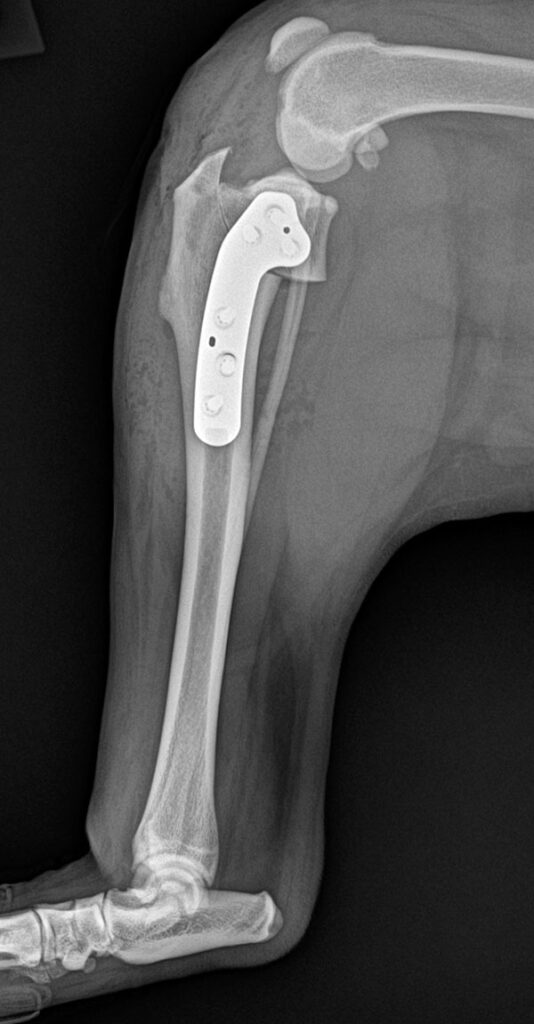A TPLO, or Tibial Plateau Leveling Osteotomy, is a surgical procedure commonly performed in veterinary medicine to treat cranial cruciate ligament (CCL) disease/injury in dogs. The CCL is analogous to the anterior cruciate ligament (ACL) and often the two terms are used interchangeably. This ligament is crucial for stabilizing the knee joint in both humans and dogs. Instability within a joint will cause undue wear and tear on the joint cartilage, leading to osteoarthritis. Thus, providing stability for the joint is critical for long-term success. Treatment of this problem usually involves two major steps:

1) Joint Exploration – best performed with arthroscopy, a small camera in the joint.
2) Joint Stabilization – generally best treated with TPLO but other procedures are available.
Joint Exploration
It is absolutely necessary for your surgeon to provide some type of inspection of the inside of the joint in order to confirm the diagnosis, remove diseased ligament and identify other common injuries such as meniscal tears (a torn cartilage pad). Joint inspection can be performed via open arthrotomy (an incision into the joint) or arthroscopy (exploration of the joint using a tiny camera).
The surgeons at Spry Companions have specialized training in arthroscopy and elect to utilize this method of joint exploration because it is the most minimally invasive option and it is best for our patients. The arthroscopic method (use of tiny cameras) is:
- Less invasive
- Reduces pain
- Improves function following surgery
- Minimizes progression of arthritis
- Allows better visualization of other structures within the joint, including meniscus
Some surgeons utilize arthroscopy only to confirm the diagnosis and then open the joint. Just because a surgeon utilizes a tiny camera does not mean they practice in a truly minimally invasive manner. Should a concurrent meniscal injury be identified on arthroscopy, some surgeons will open the joint with a larger incision. Initial use of a small camera with conversion to a large incision cannot be considered “minimally invasive.” Fortunately, the surgeons at Spry Companions have advanced arthroscopic training and high-definition equipment, so meniscal tears can also be managed through arthroscopy. Therefore, it is important to ask your surgeon if all problems identified in the joint will be addressed through the camera in addition to confirming the diagnosis (simply looking in the joint).
TPLO – Tibial Plateau Leveling Osteotomy
Following joint inspection, a stabilizing procedure is performed. TPLO is generally regarded as the best procedure to address instability, but other procedures might be discussed depending on the patient’s needs. During a TPLO procedure, the surgeon makes a small incision below the knee joint. A cut in the upper portion of the tibia (the shin bone) is made, known as an osteotomy. Once this osteotomy is completed, the upper bone segment is rotated a precalculated amount to alter the joint mechanics, which stabilizes the joint. The goal is to reduce the joint instability caused by the damaged CCL. Once the reorientation is complete, the surgeon stabilizes the bone with a specialized bone plate and orthopedic screws to allow for proper bone healing. Over time, the bone heals in its new position, providing continued long-term stability of the knee joint and reducing pain and lameness.
TPLO is considered a highly effective surgical treatment for CCL injuries in dogs. Traditionally, larger breeds or those with active lifestyles were thought to benefit the most, but most surgeons have come to recognize that many smaller dogs have some of the most significant instability and benefit from TPLO just as much. The procedure aims to restore normal joint function and improve the dog’s quality of life by alleviating pain and promoting better mobility.
